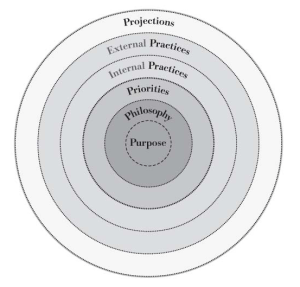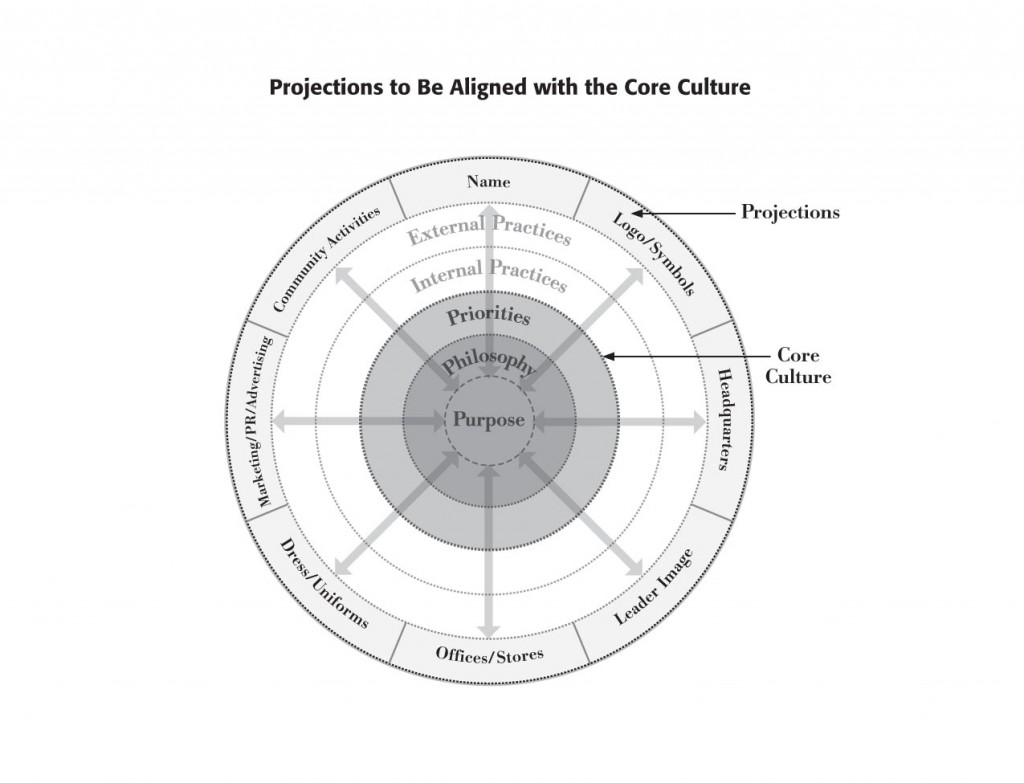Projections must be aligned with the Core Culture

Projections are the final P in the Five Ps. The Five Ps are Purpose, Philosophy, Priorities, Practices, and Projections. Projections represent the images of the organization.

The Five Ps
Projections are not the substance of your Core Culture. Instead, they are the reflections of the organization to the public. Think of Projections as images of the organization. These images are a key component of the corporate brand.
 For example, Projections include the name of your organization; its logo and other corporate symbols; the location of your corporate headquarters; the image of the leader; the design and appearance of your offices and stores; employees’ dress or uniforms; marketing, public relations and advertising; and your community activities. Each of these areas must be aligned with the Core Culture to portray a portrait consistent with the Core Culture principles.
For example, Projections include the name of your organization; its logo and other corporate symbols; the location of your corporate headquarters; the image of the leader; the design and appearance of your offices and stores; employees’ dress or uniforms; marketing, public relations and advertising; and your community activities. Each of these areas must be aligned with the Core Culture to portray a portrait consistent with the Core Culture principles.
In most organizations, changes in Projections are easier to manipulate than changes in Practices. But Projections are very important internally and externally. Projections are symbolic and emotionally relevant to employees.
Changes in Projections can have an impact on how employees feel about the organization. For example, a change in a symbol can have a dramatic effect on employees who are emotionally connected to the previous image.
Projections also reflect the Core Culture to those outside the organization. Changes in Projections can have an impact on loyal customers. Likewise, any inconsistencies between projected images and actual experiences can have a negative effect on your organization and your ability to drive business success.
Organizations must project images that allow their true selves to shine through.
Alignment of Projections with the Core Culture

The alignment process requires filtering each Projection through the Core Culture. To sum up, your objective is to ensure that all Projections support and reflect the Core Culture attributes. Building a Culture of Distinction requires a commitment to performing an ongoing Core Culture Alignment Audit to evaluate your organization’s consistency in projecting the Core Culture principles.
Key Points about Projections Alignment
Alignment of Projections with the Core Culture is essential for business success.
Align your Organization’s Name with the Core Culture
- The name is an important reflection of the organization to the public as well as a representation of its essence to employees. Ensure that your name reflects the Core Culture.
Align your Logo and other Corporate Symbols with the Core Culture
- Various symbols, for example the logo and other images, are associated with your organization and used as images to express it. They must reflect ideals that align with the Core Culture.
Align the Location of your Headquarters with the Core Culture
- People associate many organizations with the location of their headquarters. As a result, make sure the headquarters for your organization supports the image you choose to project.
Align the Image Projected by the Leader with the Core Culture
- The leader serves as a symbol of the organization. Therefore, the image that the leader projects can affect people’s perceptions of the organization. If that image does not reflect the Core Culture, it will lessen the value placed on the Core Culture attributes.
Align the Design and Appearance of your Offices and Stores with the Core Culture
- Employee offices and company stores are visual symbols of the culture. Therefore, be sure they project your values.
Align your Employee Dress and Uniforms with the Core Culture
- Employee dress and uniforms are visual messages of the Core Culture, both internally and externally. Consequently, they are a symbolic representation of the values of the organization.
Align your Marketing, Public Relations and Advertising with the Core Culture
- Marketing, public relations and advertising are designed to affect image and perception. Above all, keep the Core Culture at the center of all of these efforts. To sum up, be sure that the image you project is consistent with your Core Culture.
- Monitor your internet image so that it accurately portrays your Core Culture principles.
Align your Community Activities with the Core Culture
- Evaluate your community activities based on their strategic contribution as well as the benefits they offer to the community. Above all, choose community activities that reflect the Core Culture and contribute to your strategy.
Contact Sheila
Have any questions? Contact Sheila to answer any questions you have. To clarify, her management consulting firm Workplace Culture Institute is based in Atlanta, GA. And, she serves clients globally. Use the Contact Form to email Sheila.